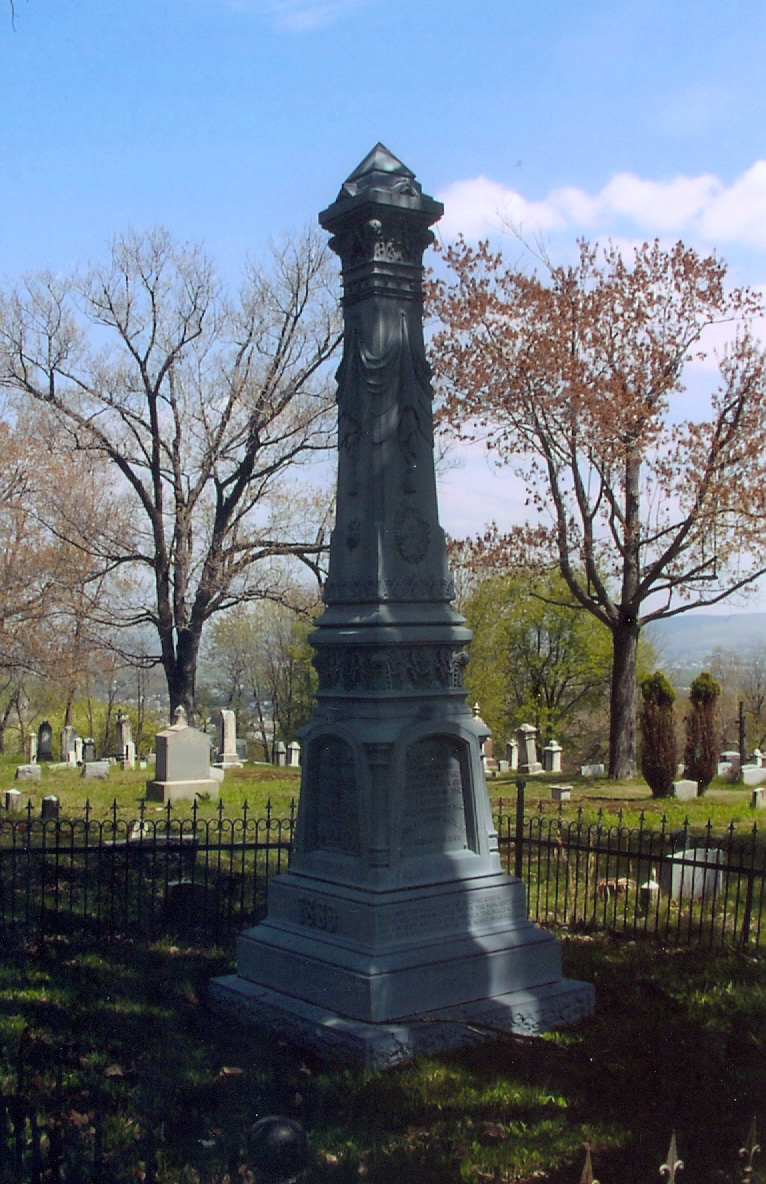The Powell Squib Factory Disaster Monument
Shawnee Cemetery
Plymouth, Pennsylvania

In the Pennsylvania anthracite fields thousands of men toiled far underground in the scores of mines that dotted the landscape. Above ground countless others, many of them family members, worked in industries that owed their existence to coal mining. Whether above or below ground it was not uncommon for there to be child labor involved. Such was the case for the Powell Squib Company whose factory in Plymouth, Luzerne County, made small explosive devices called squibs for blasting use in loosening coal from the underground seams.
The Powell factory, named after owner James Powell, employed a handful of men but the main work force numbered 84 girls ranging in age from 14-22. Work had slackened in February 1889 leading to a number of girls being furloughed. While harsh in its economic consequence to those affected, this furloughing actually saved perhaps 70+ lives for on February 25, with only 11 girls present in the factory, a tremendous explosion tore the building apart and ignited a fire that made rescue impossible. All eleven girls perished, their bodies burned almost to a crisp and their features all but unrecognizable. There was one male fatality, a foreman George Reese and the father of one of the dead girls who while initially surviving the blast succumbed to his injuries a few days later. Two of the dead were also the nieces of owner James Powell.
With no survivors the cause of the blast was never completely determined but something probably accidental in nature served to ignite a loaded squib or one or more of the many barrels of black powder stored on site.
Contemporary newspaper accounts were not terribly consistent as to names and ages of the deceased but after everyone in the company’s employ was accounted for the dead were listed as follows:
Mary Walters
Esther Powell
Ruth Powell
Gladys Reese
Jane Thomas
Mary Lake
Maggie Richards
Hettie Jones
Katie Jones
Charlotte Humphreys
Margaret Lynch
George Reese
The ages of the girls ranged from 14 or 15 to 22. The foreman George Reese was 40.
Until just a few years previous to the explosion there was a community cemetery named Shupp’s located just north of the town’s center on the river bank adjacent to a coal breaker’s culm pile. Each year the ever growing mountain of dirt, slate and coal refuse slowly engulfed one side of the cemetery covering a number of grave sites. It was decided a new cemetery was needed away from the river and coal mines. The new cemetery named Shawnee was laid out atop a nearby mountain ridge high above the river and away from any active mining. A number of Shupp’s graves closest to the culm pile were opened for re-internment purposes with remains relocated to the new cemetery while numerous families also had forebears reinterred into new family plots
Following the blast and fire a pall hung over the community. Plymouth was a small closely knit town mainly populated by Welsh Protestants. Of the deceased girls only the Lynch girl wasn’t Welsh and she was of the Catholic faith. Compared to the bodies of the mainly younger victims Margaret Lynch at age 20 and a young adult in height ironically became the only victim whose remains were positively identified. Understandably, her family chose a Catholic burial in St. Vincent’s Cemetery in nearby Larksville. Plans were then made for a mass burial at Shawnee Cemetery where nine of the Welsh girls and George Reese were laid side by side together in a large single grave. The final resting place for Charlotte Humphreys is unknown to me and I’m curious as to how it is known that she is the missing victim from the Shawnee mass burial if only one set of remains could be positively identified.
Today a lone marker, again a white bronze, stands in mute testimony to the loss of 10 lives. White bronze memorials frequently have bolted plaques on one or more sides of the memorial that could be cast with appropriate text. One plaque on the Shawnee Memorial pays tribute to the tragedy and its remembrance while the remaining three contain the names of the victims and their ages. Underneath the first plaque along the base is part of a local poem that reads…
TOGETHER THEY SLEEP ON THE SLOPING GREEN
WHERE THE FLOWERS BLOOM NEATH THE SUNLIGHT BEAM
AND THE SOFT BREEZES SIGH THROUGH THE WILLOW TREE
THAT NODS O’ER THE GRAVE IN THE SUNNY SHAWNEE
LEGGE
One of my maternal great-grandmothers lived in Plymouth at the time of the disaster and died the following year in 1890. She, too, is buried at “Old Shawnee” and her grave is but a short distance from that of the girls and Mr. Reese. During my first visit in 2001, Shawnee appeared to be largely neglected with high grass, weeds, brambles and poison ivy consuming the grave sites and many markers broken or ravaged by the elements. Subsequent visits showed some effort at cleanup and restoration. Today there is an active Shawnee Cemetery Preservation Association that seeks to restore the cemetery grounds. Progress has been slow but ongoing. The Powell Squib Disaster Monument, while not the only tombstone of importance, remains in good condition and appears to get continued attention.